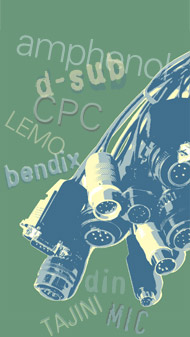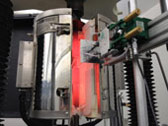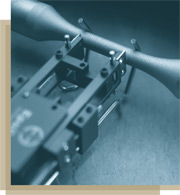

All of Epsilon’s strain gaged transducers employ a full wheatstone bridge design. They are powered by an excitation voltage, typically between 5 and 10 VDC. The output of the extensometer is proportional to the excitation. For this reason the calibrated output is often expressed as mV/V value. An extensometer with a full scale span of 2.345 mV/V will have a full scale output of 23.450 mV if the excitation is 10V. This span data is provided by Epsilon on each extensometer test certificate.
All strain gaged sensors must be connected to some external electronics to provide readings. The electronics provide the excitation and normally amplifies the sensor’s output to a high level DC voltage. This resultant voltage is used for readout or control of the test machine. In digital systems the voltage output is converted via data acquisition hardware into engineering units of strain. In instances where a chart recorder or X-Y recorder is used, the output is set to easily yield a specified strain/cm on the graph.
When any new device like an extensometer is first used, the sensor must be calibrated with the electronics to ensure proper configuration. There are several ways to accomplish this. Generally the process is very straightforward. If your extensometer will be connected to an available strain channel in your test controller, Epsilon can normally supply the unit with the correct connector to plug directly in. For external data acquisition systems, a strain gaged signal conditioning module capable of providing the excitation is required. Often this is part of the data acquisition system. For systems that require high level inputs or for use with chart recorders and X-Y plotters, Epsilon offers optional signal conditioning electronics.
Calibrating extensometers with existing electronics
REQUIRED FOR ANY EXTENSOMETER YOU BUY, THIS PROCESS CAN BE PERFORMED MANY WAYS, MOST OF WHICH ARE QUITE SIMPLE. THE MOST COMMON OPTIONS ARE AS FOLLOWS:
Using Epsilon’s Calibration References
As detailed on the shunt calibration module page, this is a very quick and easy way to set your electronics, regardless of brand.
The VREF module performs the same function as the shunt calibration module, but it does it for capacitive devices, not strain gauge devices.
With signal conditioning electronics from Epsilon
All extensometers purchased with electronics from Epsilon are shipped as fully calibrated systems. No further calibration is required. Periodic re-calibration can be performed by Epsilon.
With an extensometer calibrator from Epsilon
Epsilon’s Digital Electronic Calibrators are the easiest to use units available. These calibrators provide an ideal way to perform calibrations if you have many extensometers. They allow you to check many data points along the curve for the highest accuracy. The new 3590VHR calibrator meets the accuracy and resolution requirements for ASTM E83 Class B-1 for a 6 mm gauge length and greater extensometers and ISO 9513 Class 0,5 over the full measuring range of the calibrator.
By calibration services such as the equipment manufacturer
Epsilon’s extensometers can be calibrated with test controls by any third party calibration service with the capability of calibrating extensometers. Many customers have their entire test machine re-calibrated annually by the service department of the manufacturer. This includes the load cell, extensometers and any other installed sensors. Most calibration services will have no difficulty calibrating Epsilon’s extensometers.


Photo of Epsilon Model 3549 courtesy of Laboratory Testing Inc. www.labtesting.com

